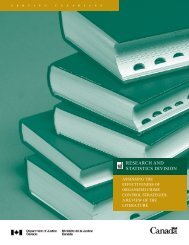National Threat Assessment 2008. Organised Crime - Politie
National Threat Assessment 2008. Organised Crime - Politie
National Threat Assessment 2008. Organised Crime - Politie
You also want an ePaper? Increase the reach of your titles
YUMPU automatically turns print PDFs into web optimized ePapers that Google loves.
In recent years, the integration phase and the role of ‘constructors’ and<br />
‘bankers’ in this phase have been the subject of a lot of (media) attention.<br />
This phase mainly concerns investments in property, not only portfolio<br />
investments but also investments in buildings that are used for other criminal<br />
activities. The buildings might be used as brothels, for example, where women<br />
are forced to work as prostitutes, or as premises in which to cultivate cannabis.<br />
Investments are also made in legal companies – often catering establishments –<br />
to mix the legal income with criminal proceeds to give the criminal proceeds<br />
a seemingly legal origin.<br />
3.6.3 Scale<br />
A total of 647 criminal organisations were identified in the 2005–2006 period.<br />
Around one third (226) were (also) involved in money laundering. Of these 226,<br />
there were 21 organisations that were exclusively involved in money laundering<br />
for other criminal organisations. These organisations were mainly active in the<br />
placement phase in which they exchanged and couriered funds; there were<br />
fewer organisations that set up financial constructions to conceal criminal<br />
proceeds. Money laundering organisations involved in the integration of<br />
laundered money into society have contacts with professionals who have specific<br />
expertise or powers that the organisation needs. The most frequent contacts are<br />
with accountants, financial experts and civil-law notaries, and to a lesser extent<br />
with lawyers.<br />
Cases of a single person working for several criminal organisations are quite<br />
frequent. The number of financial service providers that are culpably involved<br />
in money laundering appears to be limited.<br />
Hardly anyone is willing to make a statement about the size of the amounts<br />
invested in property by (individual members of) criminal organisations. Only one<br />
case file reported that, on the basis of money confiscated, 11 million euros of<br />
criminal proceeds had definitely been invested in property. Most of the people<br />
involved agree that this is an underestimate, but opinions on the actual full<br />
amount differ.<br />
It can be argued that only the ‘top layer’ of criminals in the Netherlands are left<br />
with enough money to invest in property, but the exact amount involved remains<br />
unclear. Most experts agree that there has not been an increase recently, and<br />
that such an increase is not expected to occur in the next few years either.<br />
An indication of the number of suspect transactions on the property market<br />
can be obtained from the number of buildings that change hands several times<br />
within a short period of time whereby major price fluctuations are observed.<br />
132 <strong>National</strong> <strong>Threat</strong> <strong>Assessment</strong> 2008 – <strong>Organised</strong> crime








